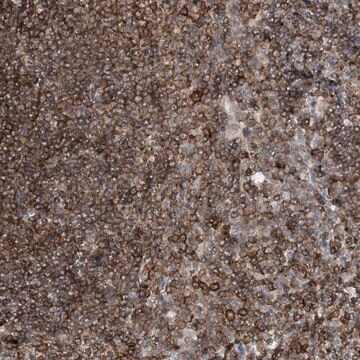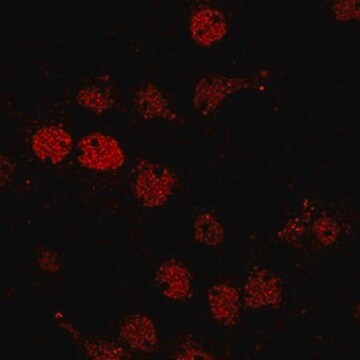MABE1112
Anti-PRMT9 Antibody, clone 128-29-1
clone 128-29-1, from mouse
Sinonimo/i:
Putative protein arginine N-methyltransferase 9, Putative protein arginine N-methyltransferase 10
About This Item
Prodotti consigliati
Origine biologica
mouse
Livello qualitativo
Forma dell’anticorpo
purified immunoglobulin
Tipo di anticorpo
primary antibodies
Clone
128-29-1, monoclonal
Reattività contro le specie
human
Non deve reagire con
mouse
tecniche
immunocytochemistry: suitable
immunohistochemistry: suitable
immunoprecipitation (IP): suitable
western blot: suitable
Isotipo
IgG1κ
N° accesso NCBI
N° accesso UniProt
modifica post-traduzionali bersaglio
unmodified
Informazioni sul gene
human ... PRMT9(90826)
Descrizione generale
Specificità
Immunogeno
Applicazioni
Epigenetics & Nuclear Function
General Post-translation Modification
Immunohistochemistry Analysis: A 1:50 dilution from a representative lot detected PRMT9 in human kidney, testis, and cerebellum tissue sections.
Immunocytochemistry Analysis: A representative lot detected a predominant cyotoplasmic PRMT9 localization by fluorescent immunocytochemistry staining of 4% paraformaldehyde-fixed HeLa cells (Yang, Y., et al. (2015). Nat. Commun. 6:6428).
Immunoprecipitation Analysis: A representative lot immunoprecipitated PRMT9 from HeLa cell lysates (Yang, Y., et al. (2015). Nat. Commun. 6:6428).
Western Blotting Analysis: A representative lot detected GST fusion protein containing human PRMT9 a.a. 401-550 recombinant fragment, but not PRMT9 a.a. 1-199, 200-400, or 551-895 GST fusion (Yang, Y., et al. (2015). Nat. Commun. 6:6428).
Western Blotting Analysis: A representative lot detected human, but not mouse, PRMT9 using lysates from various human and mouse cell lines (Yang, Y., et al. (2015). Nat. Commun. 6:6428).
Qualità
Western Blotting Analysis: 2.0 µg/mL of this antibody detected PRMT9 in 20 µg of A431 cell lysate.
Descrizione del bersaglio
Stato fisico
Stoccaggio e stabilità
Altre note
Esclusione di responsabilità
Not finding the right product?
Try our Motore di ricerca dei prodotti.
Codice della classe di stoccaggio
12 - Non Combustible Liquids
Classe di pericolosità dell'acqua (WGK)
WGK 1
Punto d’infiammabilità (°F)
Not applicable
Punto d’infiammabilità (°C)
Not applicable
Certificati d'analisi (COA)
Cerca il Certificati d'analisi (COA) digitando il numero di lotto/batch corrispondente. I numeri di lotto o di batch sono stampati sull'etichetta dei prodotti dopo la parola ‘Lotto’ o ‘Batch’.
Possiedi già questo prodotto?
I documenti relativi ai prodotti acquistati recentemente sono disponibili nell’Archivio dei documenti.
Il team dei nostri ricercatori vanta grande esperienza in tutte le aree della ricerca quali Life Science, scienza dei materiali, sintesi chimica, cromatografia, discipline analitiche, ecc..
Contatta l'Assistenza Tecnica.







